| 6/3/22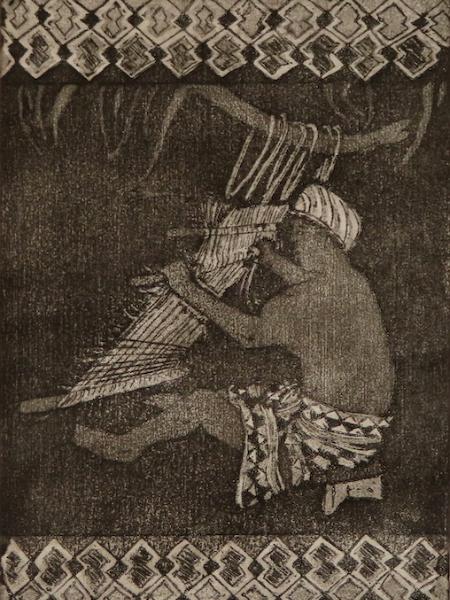 |
Country/ People: Democratic Republic of the Congo; Bantu-speaking people (Central Africa) Loom: single heddle loom Border: sample weave
mbote (mboh-teh) — Hello in Lingala, a Bantu language
Kuba: The Kuba (Bakuba) people are a large Bantu-speaking group, who live in the Republic of the Congo. In the 1600s, the Kuba Kingdom consisted of more than 18 individual tribes, and thanks to the ivory trade, this was a wealthy kingdom. Yet, while diversity was valued in artistic expression, woven raffia cloth (Kuba cloth) as a medium is most associated with this entire ethnic group. Through the years, patterns on the cloth have evolved from subtle to bold. And this may be a result of the individual groups seeking to express their own cultural identity and to exert their power through their creations. In the 1800s, Belgium, interested in the rubber trade, colonized the Congo. Despite trade with Europe, Kuba cloth became even more valued as a symbol of the traditional Kuba kingdom. Their cloth was so valued, in fact, the Kuba became known as “people of the cloth.�� Loom: Kuba cloth is made of raffia stripped from the leaves of the raffia palm tree. It is a cultural tradition that men prepare of the raffia using natural dyes (mud, indigo, etc.) and actually weave the basic cloth. They work on a unique, inclined, single-heddle loom. The women combine the pieces of raffia cloth and apply the decorative patterns. They hand embroider or applique the designs using raffia fibers in linear patterns. Ultimately, the women create a distinctive fabric with a cut-pile, velvet-like, plush effect. What is so distinguishing about Kuba cloth patterns, it its contrast of light and dark color hues and its tendance toward the abstract. A single, place-mat sized piece of fabric may take several days to create. Often the fabric pieces are patched together to form larger fabrics. Border: Sample weaving pattern. References and Links: · Command Performance: Kuba Cloths from Central Africa. https://www.mutualart.com/Exhibition/Command-Performance--Kuba-Cloths-from-Ce/14AC004D8F08EB4A· Kuba Cloth.https://artsandculture.google.com/exhibit/the-fabric-of-africa/xwISIFA_fBjSIA (Good examples of Kuba cloth)· Mokry,Fiona, Travel Trivia. 7 Unique Textiles From Around the World and How They’re Made/ Kuba Cloth· Video: "Kuba Textile Art and the Significance of Raffia Cloth in Bakuba Society” Lecture by Ashley Rickma. https://www.youtube.com/watch?v=LKLBk9dWgDc· Video: Kuba cloth from Congo - watch it being made. Learn the history. https://www.youtube.com/watch?v=taKpHyg2JmI· Your Ultimate Guide To Kuba Cloth. https://www.thulatula.com/blogs/community/your-ultimate-guide-to-kuba-cloth · Weaving Abstraction: Kuba Textiles and the Woven Art of Central Africa. The Textile Museum |
Be the first to post a comment.
|
5/28/22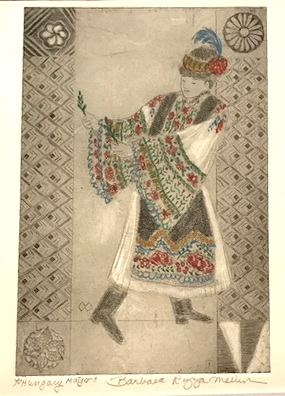 |
People/Country: Hungary Dance: Matyo Casrdas, a Traditional folk dance, attired in Matyo*embroidery Border: Zsolnay roof tiles,, Romani (Gypsy) wheel, Halas lace*, Cube House painted (Magyar Kucka) Jónapot! / Hello The Magyars arrived in the area now called Hungary around 895 CE from the Ural Mountains. The towns of Buda and Pest (shown in 1995), on opposite sides of the Danube River, joined to become Budapest in 1873 Dance: When I’m travelling, I always try to view local or traditional dance or music performance when possible. For one thing, I don’t have to know the language to appreciate the event. When in Budapest, Hungary a few years ago, I was fortunate to get tickets to view The Hungarian State Folk Ensemble/Folklor Danube Folk Ensemble, a wonderful show of traditional folk dances with traditionally attired dancers. I’m sure it was intended for tourist, but that’s what I was, and that is who is often most interested in learning about customs and costumes natives may take for grant it. This dancer is dressed as one of those performers was. Attire: The dancer here is wearing an outfit embellished with “Hungarian Embroidery”. This style of embroidery dates back to the 12 th century or earlier. One of the oldest surviving pieces of Hungarian embroidery is the so-called Coronation Mantle of King Stephen (r: 1001-1038), which is now in the National Museum of Hungary, Budapest. Women in Hungary decorated clothing, sheets, and other household items with this elaborate,, think tread embroidery. Men, considered craftsmen and usually part of guilds, decorated sheepskin coats and jackets, as well as felt mantels. There are several different styles of regional embroidery. The Matyo variation, shown here, is listed as a UNESCO Intangible Heritage Culture. Characteristically, it has brightly colored floral motifs on a black background making it particularly striking. According the website National Clothing. Org, it can take up to months or even years to make a complete set of Matyo folk clothing. Matyo embroidery not only represents a particular region of Hungary, but has come to be a symbol of the whole country. Shirts are heavily decorated with floral embroidery on wide sleeves that come down beyond the hands and are trimmed with a crotchet edging. While there were regional difference, most often traditional dress includes hats decorated with feathers or ribbons, and boots with a higher heel and sometime spurs. Embroidered aprons were also worn.The apron is usually one panel with fringe at the bottom and detailed embroidery coming about a quarter or third the way up from the hem. This outfit is from Mezőkövesd, the largest of three cities of the Matyo people in northeastern Hungary Border/sides: Zsolnay roof tiles The border is inspired by my favorite building in Budapest, the magnificent Museum of Applied Arts, designed by Art Nouveau architect Ödön Lechner. Its green and gold roof made of Zsolnay ceramics sparkles with splendor, and its imposing dome dominates views from surrounding streets. The story of Zsolnay’s tiles is fascinating, and I encourage you to research this topic for yourself. Corner, upper left: Easter Eggs Easter is widely celebrated in Hungary, and traditions have evolved, from “locsolkodás” or “Sprinklings” (throwing water on young women) to distinctively decorating Easter eggs. There are actually several different techniques for egg decorations including painting (some of the same patterns as the embroidery), dying and two popular traditional methods: berzseles and iras. Berzseles involves using natural materials, such as leaves to create the pattern. Leaves are secured to the egg with mesh fabric (panty hose will do) and placed into the dye bath. When the chosen color is reached, the egg is lifted and the leaf removed, leaving a subtle, but lovely, stencil pattern. The dyes are also natural, such as onion skin for brown and beets for purple. The Iras technique picture in the corner is a little more complicated. Iras literally means “to write.” You “write on the egg (or draw a pattern) with a specialize metal tool using hot wax. After dying the egg, the wax is removed to reveal the design, much like Ukrainian Pysanky eggs (or batik fabric. Corner, upper right: Gypsy Wheel Romany Gypsies and Irish Travellers are legally recognized as ethnic groups, and protected from discrimination by the Race Relations Act (1976, amended 2000) and the Human Rights Act. The Roma chakra, was adopted in 1971 at the First World Romani Congress as the official symbol of the Roma (“Gypsy”) people, resembles a Hindu Chakra wheel, and not unintentionally. Chosen deliberately to honor the Romani’s Indian heritage, the sixteen spoked wheel adorns the Romani (Romany) flag, and is reminiscent of the wheels of the Vardo, or Wagon, which has served as the home for Romani peoples over time. Gypsies make up Hungary’s largest ethnic minority of about 3.2 percent of the population to even 7 % -10% depending on how “officially” reported the numbers are. They get their name from the mistaken conception that they were originally from Egypt. Actually, they are a separate, recognized ethnic minority that probably emigrated from India (Rajasthan and Punjab) to Europe in the 11th-14th centuries. They are also called Travelers (especially in Ireland) because of their nomadic a culture. Generally, they prefer to be called Roma, since they belong to the Romani group of peoples and speak the Romani language. Yet, as with many minorities in Europe and elsewhere, there is poverty and prejudice associated with this group. They were victims of the Nazi Holocaust. The Roma have contributed a significant identity especially in the form of “Gypsy” music and dance to the Hungarian culture. Many musicians play professionally in restaurants (often catering to tourists in Budapest), where I heard them, or in performances of folk dance and music in concert halls, where I also view them. Corner, lower right: Cube Houses: (Magyar kocka) The Hungarian Cube ( Magyar kocka) or Kádár-kocka (Kadar Cube) is named after János Kádár, the Communist leader of Hungary between 1956 and 1988. It's a standardized type of residential house built in Hungary after WWII. There are still tens of thousands of them left, and people have personalized them in gorgeous ways. Hungarian cubes usually have a floor area of 872 sq ft (81 sqm, 9x9 m) or 1076 sq ft (100 sqm, 10x10 m). Ornamental or geometric decorations on facades were the only way to individualize them. Some of the finest examples were photographed by Katharina Roters and published in her book Hungarian Cubes, available from European online booksellers . Corner, lower left: Halas Lace Different regions throughout the country have their own styles and patterns of lace making. But Halas Lace, from the town of Kiskunhalas, is especially identified with Hungary. This lace is so prized in Hungary that is often given to as an official gift to heads of states, such as Eleanor Roosevelt, Charles I of Austria, and Pope John Paul II. The lace uses sixty kinds of stitches and extremely thin thread. It is tremendously tedious to make. There are less than 100 women who know how it is made today. References: · Folk costume and embroidery/ Costume and Embroidery of Mezőkövesd, Hungary http://folkcostume.blogspot.com/2014/06/costume-and-embroidery-of-mezokovesd.html · Hungarian Coronation Mantle. Textile Research Center.https://trc-leiden.nl/trc-needles/individual-textiles-and-textile-types/secular-ceremonies-and-rituals/hungarian-coronation-mantle · The Hungarian Cube (Magyar kocka) · Meier. Allison. How Hungary’s Painted Homes Rebelled Against the Socialist System· Hungarian Embroidery. Textile Research Center. https://trc-leiden.nl/trc-needles/regional-traditions/europe-and-north-america/embroideries/hungarian-embroidery · Jones, Marilyn. Discovering Medieval Budapest. Renaissance magazine. # 110 May 2017. Pgs. 28-30 · The living tradition of lace-making in halas http://szellemikulturalisorokseg.hu/index0_en.php?name=en_0_halasi_csipke· Museum of Applied Arts Roof . http://www.jasonjacques.com/historic/zsolnay· National clothing.org/Europe Traditional embroidery and folk costumes of the Hungarian Matyó community 13/1/2018· Video: https://www.viator.com/tours/Budapest/Hungarian-Folk-Performance-in-Budapest/d499-5808SHOW · Hungarian Easter Eggs.https://clevelandhungarianmuseum.org/hungarian-easter-eggs/ · Zsolnay market, St. Matthias, Applied Art museum others. https://www.youtube.com/watch?v=29JGZa2Ycf8 · Traditional costume of Hungary. Mix of Renaissance and Baroque creates unique folk outfit 30/6/2016 |
Be the first to post a comment.
|
5/23/22 |
Country/ People: Thailand. Padaung/ Kayan Loom: Backstrap Border: Sample weave ဟလို “Mingalabar” Pronounced "ming-gah-lah-bahr" / Hello in Burmese (not Karan)
Background: One of the largest ethnic hill tribe groups, comprising almost half of all hill tribe peoples, is the Karen or Kayan tribe, with more than 300,000 living in Thailand. They came as refugees from Myanmar (Burma). There are four sub groups, each with their own language and traditional attire. By far the most recognizable of the Karen sub-groups is the Padaung, often call the “long-neck tribe.” Padaung women wear coils of brass round their necks, and some also wear metal rings on their ankles and lower legs. An ancient southeast Asian legend claims the brass rings protect women from tiger attacks, since the wild animals go for the neck and ankles of their victims. As Katie Foote discusses in the reference below, Ethical Travel: Should You Visit Thailand’s Long Neck Women Villages, it may seem intrusive and even exploitive to visit these hill tribes. Clearly, if you do go, as I did, you must do some research first and find responsible avenues, where traditional customs are protected and women are provided welcomed economic opportunities. I met the woman pictured here in Thailand, where she shared her her skill, smile and customs with us.
Loom: Karen women traditionally use a back-strap loom to create weavings using cotton treads and natural dyes. I am particularly fond of the Padaung weaving in a kind of zig-zag pattern, created with incredibly fine treads that are not tightly woven into the patten (see image below). Many of the hill tribes also weave with beautiful, shimmering Thai silk. Each of the ethnic tribes has a unique variation on traditional designs and use of color. In many instances, weaving has become a profitable route to independent income, replacing earlier opium growing.
Border: This design is copied from a hand-woven, silk scarf I purchased from the woman I have pictured in the image. She was so friendly, and we seem to communicate even though we didn’t speak each other’s language. She agreed to having her photo taken, as she was rightly proud of her handiwork. References and Links: · Foote, Katie, Ethical Travel: Should You Visit Thailand’s Long Neck Women Villages? 9/12/18 ( https://epicureandculture.com/thailand-long-neck-women/)· Hill Tribes of Thailand.https://www.challengesabroad.com.au/blog/the-hill-tribes-of-thailand/· Hill Tribe Weaving Class in Chiang Mai. https://www.youtube.com/watch?v=hOzkwZg5_kE· Thailand weaves colorful future for ethnic hill tribes through textiles. https://www.channelnewsasia.com/asia/thailand-doi-tung-chiang-rai-weaves-for-ethnic-hill-tribes-1311306 · Visiting a Long Neck Tribe Ethically. https://travellingjezebel.com/should-you-visit-a-long-neck-hill-tribe-in-thailand/ |
Be the first to post a comment.
|
11/27/21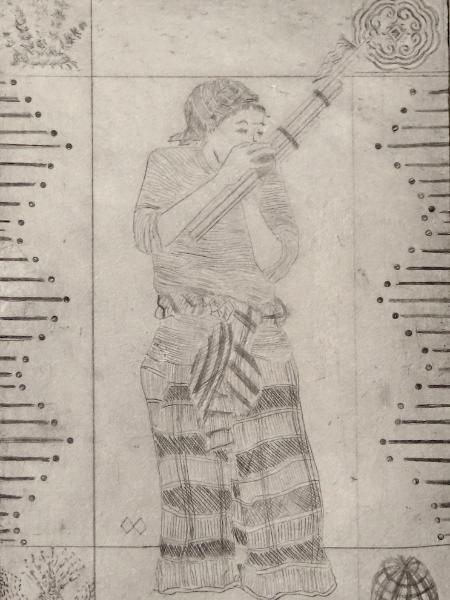 |
People/Country: Laos (Lao Peoples’ Democratic Republic) Instrument:/ (Figure) Khene* ( bamboo mouth organ, metal reed) Border/Corners: Night Market book, Baci ceremony, Hmong applique, Caged bird, Day Market, Luang Prabang* temple mosaic
§ ສະບາຍດີ (sa-baai-di) Hello The largest ethnic group in the country is the Lao people, who give the country’s name it’s significance, but the official name is “the Lao People's Democratic Republic” The National Instrument of Laos is the khene, (pronounce caan), a kind of mouth organ, made with bamboo "pipes' connected in a hollow wood reservoir through which air is blown. Similar instruments date back the the Bronze Age. The most fascinating part of this small instrument is its brass or silver free reed. It is related to later free-reed instruments, such as the harmonica or bandoneon and the Chinese sheng. The Khene is also popular with the ethnic Lao populations in Cambodia and Thailand and with the Tai and Muong people in Vietnam. The Khene is traditionally played at many ceremonies and celebrations, including weddings, funerals, Buddhist celebrations, dancers and concerts.
The figure in this image is wearing traditional Lao male clothing. Unlike the long, wrap around skirts for women called Sinh, the Salong for men is actually a loose-fitting pantaloon or peasant pants, usually tied at the waist. Border and Corners: I had fun thinking about what to use for the border and corner designs, since I had so many fond memories of my visit to Laos, and I wanted to share some to those memories (traditions and stories) with you.
Corners: The upper, left corner represents the decorative marigold and banana leaf centerpiece of the Baci Ceremony or Soukhwan. This is not so much a religious ceremony, but rather a cultural act of welcoming. It is used for visitors, at weddings, and to welcome new babies. We were fortunate to be part of this ceremonial welcome when we arrived in Luang Prabang, Laos. By tying a white cotton string around the guests wrists, all the parts of the soul are summoned back together.
The upper, right corner is a common, stylized pattern meant to represent an elephant's footprint among the Hmong people, also known as Lao Soung (highland people), the third largest ethnic group in Laos, representing almost 10% of the population. Hmong people take much pride in their paj ntaub, pronounced pa ndau or flowery cloth and sewing skills, which include labor-intensive appliqué, reverse appliqué, batik, cross stitch, and embroidery work. Traditionally, they make new clothing for the February start of the new year. Their oral history tells that while in China (where the Hmong originated), they were forbidden to use pak ntaub scrip (their picture-writing language), so women sewed symbols into the clothing as a “secret message” presented as decoration. The pattern in the upper right corner represents an elephants foot ( ko taw ntxhw) and is a symbol of prosperity. This site has images of several Hmong symbols and motifs: http://www.hmongembroidery.org/symbols.html One symbol shown on this site shows two curved shapes that come together in the middle to form a stylized open diamond shape. This is the Ram’s horn ( Kub yaj) and represents wisdom. We found these patterns repeated on many of the handmade items, we saw in Laos and Thailand among the various Hmong-related ethnic groups. The lower right corner shows Laotian bird cages. I first saw these bird cages with live birds inside at the morning market in Luang Prabang. Along with farm fresh produce, visitors may purchase these birds to set them free. There is a Buddhist belief that dates back to a fifth century text, which states that freeing captive animals can help one gain spiritual merit as it is an act of compassion. Ironically, today, the trade in securing birds for release is making conservatives question that compassion.
The lower left corner features a peacock, one of the beautiful mosaic patterns on walls of Wat Xieng Thong (Temple of the Golden City), Luang Prabang’s most famous temple. Built in c. 1560, it was once the site of King Coronations. The most striking decoration (among many) is the beautiful, glass mosaic on the back wall depicting the tree of life with a blue peacocks on either side. Thirty-four temples in Luang Prabang, including this one, are on the UNESCO World Heritage list. Luang Prabang literally means “the place of the Buddha,” Cave, and the city in the northern part of the country is a UNESCO World Heritage Site. The Pak Ou Caves, once a 16th century monastery in the limestone cliffs near the Makong River, are full of thousands of statues of Buddhas left over the centuries by worshipers and travelers. Fortunately, there are wooden steps leading to the cave, so I didn't have to scale a mountain to visit.
The side borders are taken from a simple pattern that appears on a handmade book that I purchased at a night market in Luang Prabang. I was struck by how effective such an unpretentious arrangement of lines could be. Wondering through the night market was a wonderful experience. Once the main shops close and traffic is halted, the streets become full of bustling people (shoppers, tourists, young folks and older), with shops, stalls and blankets spread on the ground offering handmade crafts, everyday items and exotic treasure, street food and the sights and sounds of an after-hours economy. In addition to the book, my husband and I purchased a hand-woven, silk scarf; a beautifully hand-carve wooden bowl, and local food. He got tons of great photos, and I got a gold-fish pedicure (The fish feast on dried skin.) References: Dohn121, Khene: The Mouth Organ of Laos, Hub Pages. 10/11/2019. https://discover.hubpages.com/entertainment/Khene-The-Mouth-Organ-of-Laos Nuwer, Rachel, Buddhist Ceremonial Release of Captive Birds May Harm Wildlife. Scientific American. https://www.scientificamerican.com/article/buddhist-ceremonial-release-captive-birds-may-harm-wildlife/ 8/1/2012 Pak Ou Caves.
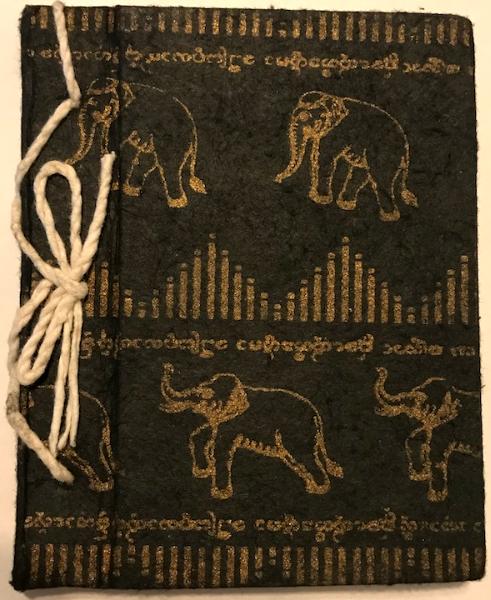 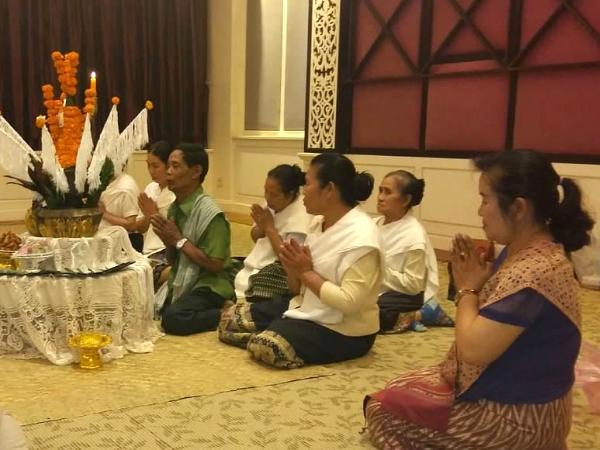 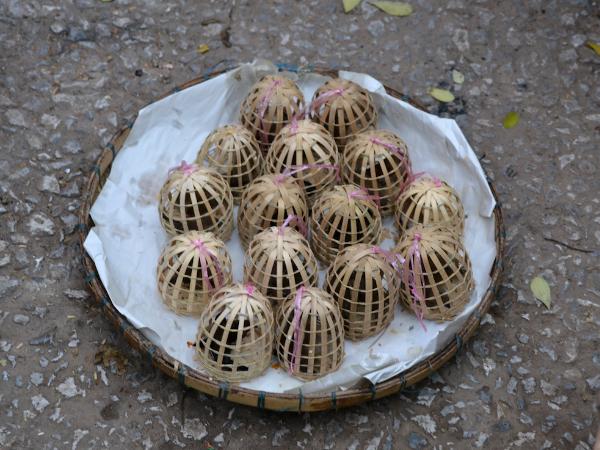 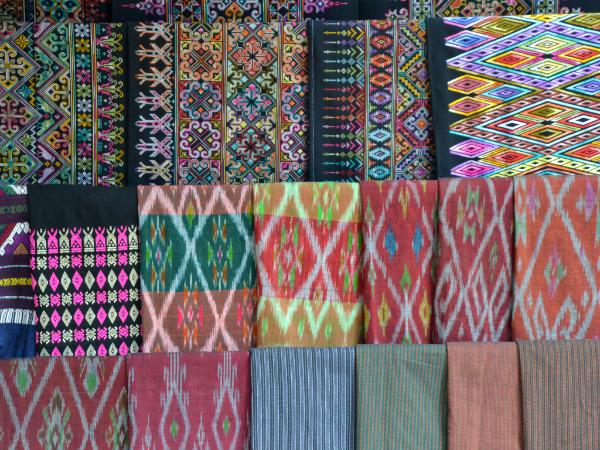  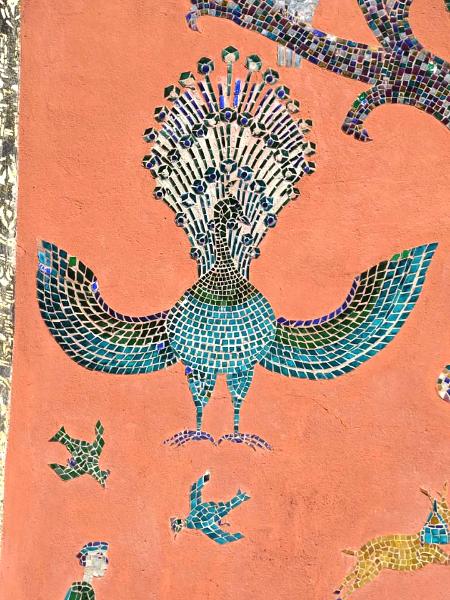 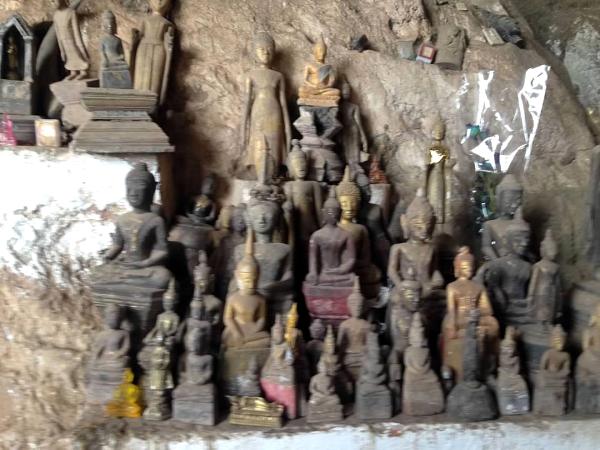 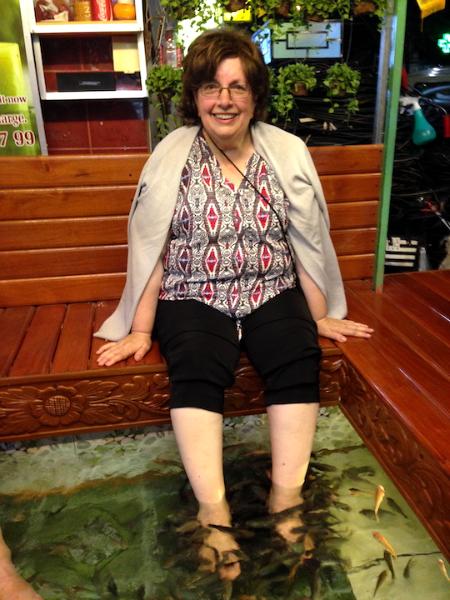 |
Be the first to post a comment.
|
9/4/21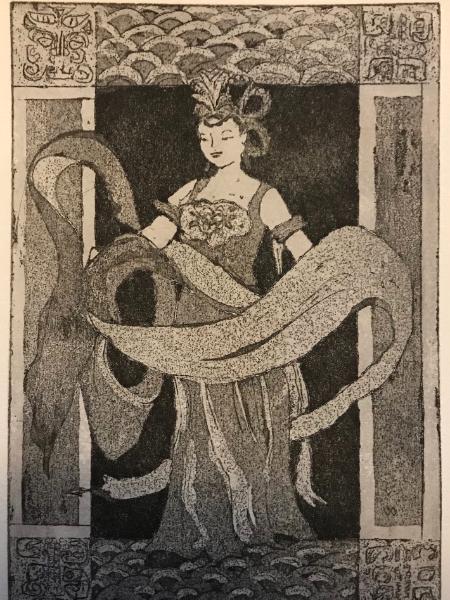 |
Country/People: Chinese (Tang dynasty) Dance: Palace White Linen Dance Border Porcelain ceramic pattern, T’ao Ti’eh corners 你好[ nǐhǎo ]Hello Dance: The Tang Dynasty (618-907) was a period of peace and high culture and is considered China’s Golden Age. In this period, the academy for poets was founded, and nearly 50,000 poems were written and preserved. Woodblock printing was established, which helped the spread of Buddhism, and Buddhist Festivals became popular. Music and Dance were part of courtly activities, and Chinese Painting developed and advanced, thanks to the patronage of the imperial court. One of the dances performed for the emperor was the “White Linen” dance (白紵舞), in which the female dancers gracefully move long, extensions of their sleeves in circular motions, meant to resemble clouds chasing the moon. Although the dance existed as far back as the Jin dynasty (265-316), it reached its peak during the Tang dynasty. I was fortunate to see a performance of Tang Emperor dances and music while in Xi’an in 2005, and this dance was by far the most elegant and graceful. Attire: During the Tang dynasty, times were not only prosperous and peaceful, but also in some ways liberating, at least as far as fashion was involved. Looser silk dresses, longer wing-like sleeves and even low-cut gowns were popular. Hair styles usually covered the temples, but had a bun and braid loops in a variety of styles, such as the one on our figure. Silk fabric weaving also flourished during this period. Sericulture or silk weaving had been part of Chinese culture for thousands of years, but during the Tang dynasty there were eight different types of silk fabrics, classified by their particular weaves, such as gauzes, damasks, brocades, crepes, and tapestries. (Silk was a precious commodity and traded for horses on the Silk Road.) While the dresses of the dancers may have been silk, the ribbon-like sleeves were made from a “bast” fiber, (hemp, ramie or kudzu), classified as linen. Border: The top and bottom mid sections of the border are inspired by Chinese porcelain patterns. Porcelain was probably “discovered” during the Tang dynasty, but production really flourished in later dynasties, reaching peak periods during the Ming dynasty (1368-1644) and Qing dynasty (1644-1912). The addition of kaolin, a soft, white clay material and firing the ceramics at a very high temperature are what gives porcelain pieces their distinctive, translucent look. For a long time, the formula was a prized secret of the Chinese. (That is why this fine ceramic ware is often called “China” in other countries.) The corner images are t’ao-t’ieh figures found on bronze vessels from the much earlier Shang Dynasty (ca. 1600–1046 B.C.E.). The Shang t'ao-t'ieh image exists around a pair of circles or ovals placed near enough to each other to intimate eyes. It is the presence of these eyes that gives the t'ao-t'ieh its life and creates in it an entity, albeit an incomplete one. Since the ability to produce a representational figure existed during the Shang dynasty, the lack of such representational form in the t'ao-t'ieh images suggests a purposeful omission. I suspect that the t'ao-t'ieh depicts a spirit or supernatural deity whose form is unknown, but whose being is incorporated into the bronze.
References and Links History of Porcelainhttps://www.artistictile.net/store/info-history-of-porcelain.htmlSong, Candice. 9.3.2021. The Tang Dynasty Showhttps://www.chinahighlights.com/xian/attraction/tang-dynasty-show.htm Traditional clothing of Chinese dynasties: from Xia and Shang Dynasties to Tang Dynasty http://nationalclothing.org/asia/39-china/352-traditional-clothing-of-chinese-dynasties-from-xia-and-shang-dynasties-to-tang-dynasty.html The Tang Dynasty in China: A Golden Era Asian Traditional Theatre & Dance. https://disco.teak.fi/asia/the-tang-dynasty-618-907/ |
Be the first to post a comment.
|
9/1/21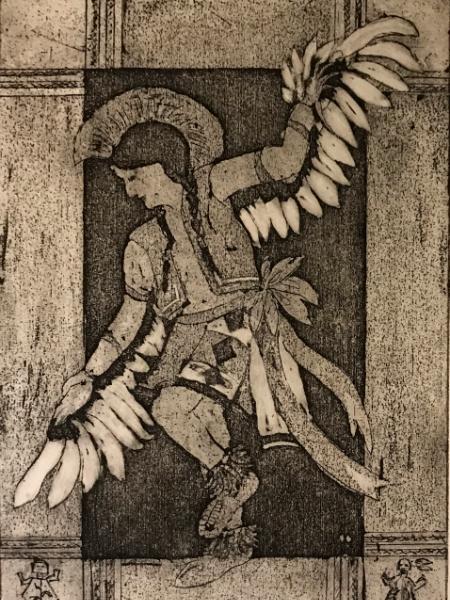 |
Country/ People: U.S.A. Native Americans Dance: Eagle Dance, Cherokee (and others) Border: Navajo Sand paintings
Osiyo Hello (in Cherokee)
The Eagle Dance has been performed by many Native American tribes or nations including the Iroquois, Comanche, Calumet, Cree and Cherokee. Today, it is often part of celebrations of the Jemez and Tesuque tribes of New Mexico. The eagle holds a special place in Indian cultures, representing wisdom and strength. Some groups believed the Eagle held supernatural powers that allowed it to transport prayers to the gods. The dancer, adorned with feathers strapped to his arms like wings, imitated the movements and activities of the eagle. Using only white (or nearly white) eagle feathers, false wings up to six feet long are created for the dancer to wear across his shoulders and arms. (Native Americans have been granted special privileges to collect and use these feathers, generally illegal under the Bald Eagle Protection Act of 1940, for ceremonial purpose.) These ceremonial eagle wings not only represent the majestic bird but add drama and accentuate movements in the dance. At times in our history, the use of feathers in ceremonial dances and religious rites was used as an excuse to forbid traditional dances and practices by Native American. An interesting article that discusses this topic was published in 1991. (N. Brown, .Donald "Indians, Feathers, and the Law in Western Oklahoma" Expedition Magazine 33.2 (1991): n. pag. Expedition Magazine. Penn Museum, 1991 Web. 03 Feb 2021 http://www.penn.museum/sites/expedition/?p=3960) The Eagle Dancer wears soft, leather moccasins, shoes worn my most Native Americans. There were individual style and different ornamentations, but the basic concept remained across Native nations. Often made of deerskin, they allowed the wearer to move quietly and feel the ground, but protected him/her from thrones and other impediments. Border: On the four corners of the border, I have indicated sand paintings. Sand paintings were another way that some Native Americans believe they can communicate with the spirits. These are colorful, beautifully designed works of art. Although the Native Americans who originally created them did not consider them art, but rather prayer and medicine. As the name suggests, they were created of sand, with colors dyed from natural materials such as crushed stone, pollen and flowers. And they were also created in the sand as part of a healing ceremony. Once completed and sanctified, the person in need of healing sits in the middle of the image so that the spirits represented can realign the “patient” with the earth. Once the ceremony and prayers were completed, the image could be destroyed, brushed away to bring its message to the gods. In addition to the Navajo, the Hopi and Zuni Indians of the American southwest, create these ethereal paintings. The Navajo call sand painting 'iikááh, "place where the gods come and go." However, as time has moved on, many of the sand painting designs have been created on permanent surfaces (sandpaper coated) for sale as art to tourists, which helps the native economy. I modeled the four images here after sand paintings I purchased decades ago to add to my cultural collection. Some of the common symbols with stylized, geometric shaped bodies include Father Sky and Mother Earth (Taos Pueblo* UNESCO )
References: Dockstrader, Frederick J. Indian Art of the Americas, Museum of the American Indian.1973 print Eagle Dance - Unto These Hills, Cherokee, NC 201 Video. https://www.youtube.com/watch?v=JyXUvd7F0kE Native People.org Navajo SandpaintingsNationalclothing.org Native American Indian moccasins and their marvelous embellishments 10/10/2019 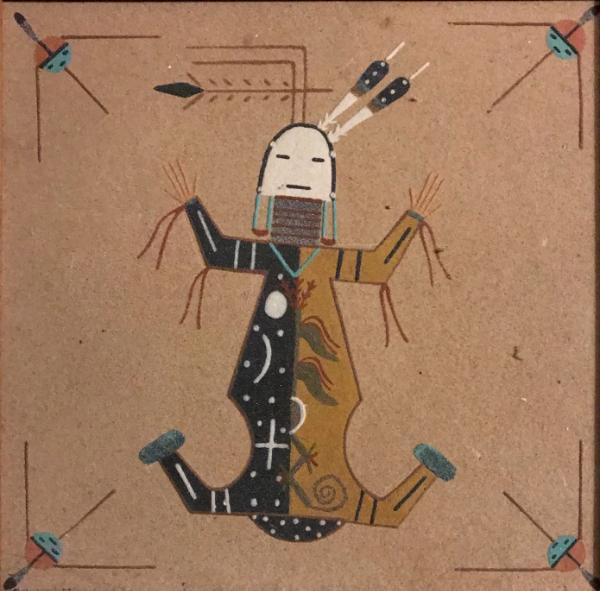 |
Be the first to post a comment.
|
4/17/21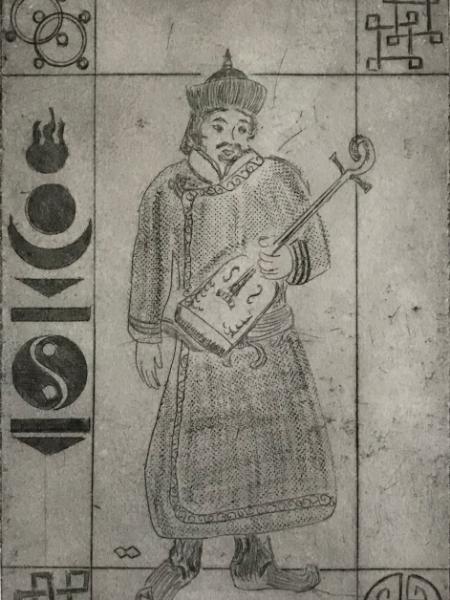 |
People/Country : Tuva, Siberia, Mongolian (Dry Point Etching) Calling image: Kloomei (Overtone Throat Singer), male in traditional deel attire with morin khuur (bowed fiddle)* Corners and Borders: Mongolian flag and symbols § sain baina uu (sain bai-na OO) — formal
§ sain uu (say-noo) — casual Hello in Mongolian, the official language of Mongolia, an Altaic language spoken by approximately 5 million people in Mongolia, China, Afghanistan and Russia. Located between China and Russia, it is one of the most sparsely populated countries in the world. You probably know it was once ruled by Genghis Khan (reigned 1206-1227) and Kublai Khan (reigned 1260-1294).
Khoomei: The "calling songs' shown here is known as Khoomei, and is recognized as a UNESCO Intangible heritage. It is created by an overtone throat singer. Actually, Khoomei is most associated with Mongolia and Tuva, an autonomous small Russian republic between Siberia and Mongolia. But, Overtone or Throat Singings is practiced in several cultures, including the Inuit people of Nanuvat, Canada, the Sardinians in Italy, and the women of Bulgaria. Overtone singing, sometimes called polyphonic chanting, diphonic singing or throat singing is a technique that results in a remarkable sound produced when the singer manipulates his or her vocal tract to produce more than one note at a time. I first heard this unusual sound at Wake Forest Museum of Anthropology, when a visiting Mongolian artist performed and explained the procedure. (See photo below.) It is almost as if the vocalist sings the "drone" note of a bagpipe, as well at the melody simultaneously. The sounds imitate sounds in nature.
Morin Khuur: The figure in this dry point etching is playing a traditional instrument, known as a Morin Khuur, or horse head fiddle. It is also recognized by UNESCO. This square box :fiddle” with two strings has evolved from the 13th century. The bow is generally made of horse hair , and there is traditionally a horse’s head carved at the top of the instrument’s neck. Attire: The Mongolian dress from head to toe is quite dramatic and meaningful. There are more than 400 styles of traditional hats that vary according to season, occasion, sex and age of wearer, and social status. They may even be made of prized materials (velvets, brocades) and decorated with gems. In mediaeval times, a fanciful knot, symbolizing power, crowned the pointed top. The calf-length tunic worn by both sexes is called a Del or Deel. Made of one piece of material. it crosses the body and buttons on the right shoulder. Each ethnic group has their own distinctive deel. (Note: Those of you interested in the artistic process might like to know that I had to recreate this entire etching because I forgot that the a print plate prints in reverse when it goes through the press. I usually think about that, but here, I forgot that would mean the Deel would botton on the left. So I had to correct that detail.) Boots: The beautiful, stiff leather books have an upturned toe, which helps with walking and prevents the foot from slipping out of the stirrup when riding. Corners: Mongolian symbols fill the corners. These are designs that trace their history to past empires and Buddhist heritage. Most are interpretations of an endless knot. Upper left: The bracelet of Khan (Khan-buguivch), Symbol of peace. Upper right: The Earrings of the Queen (khatan-suikh), Symbol of love and honesty and marital fidelity. Lower right: Buddhist Symbol, another eternal knot, also representing Mongolia. Lower left: The endless knot (ölzij - ulzii). It symbolizes the infinite love and interdependence of all things. It also represents knowledge, wealth, happiness and good karma. Borders: The national symbol of Mongolia pictured on the left side border of the etching also appears on the flag of Mongolia. It is called The Soyombo, and was created by Zanabazar, the 17th century statesman and father of Mongolian art and script. The flame at the top stands for the blossoming and continuation of the family. Its three points representing prosperity of the people in the past, present and future. The origins of the Mongolian people are represented by the sun and crescent, and the two triangles show the people’s willingness to defend the freedom and independence of the its people from enemies inside and outside the country. The two horizontal rectangles stand for honesty and justice. The actual flag patterns also has two larger vertical rectangles on the sides, which are emblems of fortified walls. However, these rather metaphorically represent strength, and stand for the Mongolian saying, “ Two humans in friendship are stronger than walls of stone.” The yin/yang symbol shows the unity of men and women. At different times and under different political rules, such as Communism, these symbols were assigned alternative meaning. The Mongolian flag contains three equally sized strips of color: a center of blue, which stands for the eternal blue sky, and two side panels of red, which represent progress and prosperity. The Soyombo symbols appear in gold, off center, on the left panel only. That is why it is only on one side of the etching’s side borders.
References: Gerelee. Mongolian Patterns. https://www.amicusmongolia.com/mongolian-patterns.html Mongolian Tours: http://www.mongolia-travel-and-tours.com/symbols-mongolia.html 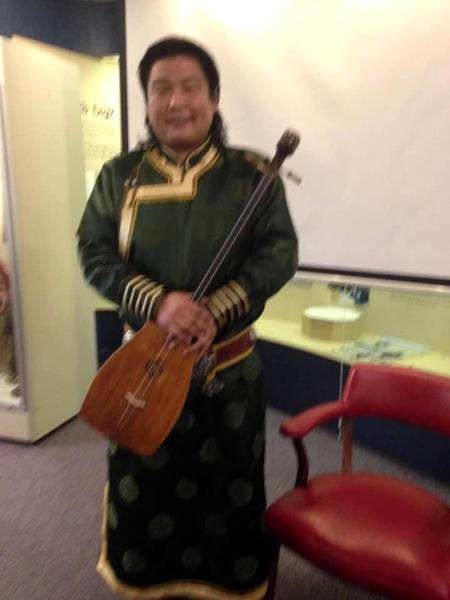 |
Be the first to post a comment.
|
3/11/21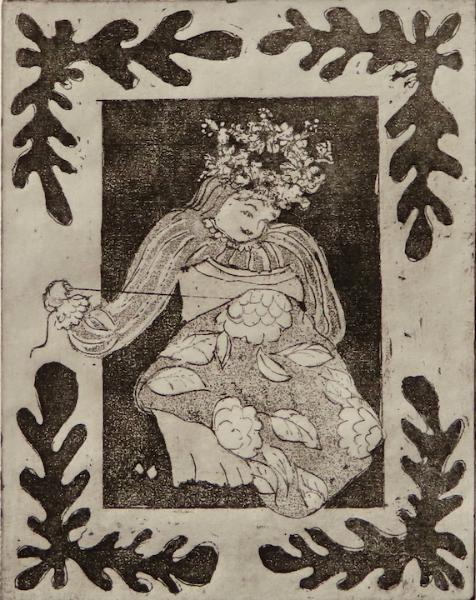 |
Country: the Cook Islands (New Zealand) Quilts Name or Style: Tivaevae Border: Tivaevae quilt sample Copper sulphate and salt etching
Kia Orana/ Hello
Named for Captain James Cook, who visited in the late 1700s, the Cook Islands consist of 15 islands in the South Pacific. They are autonomous but considered in “free association” with New Zealand. Citizens of the Cook Islands have the status of Cook Island Nationals and also citizens of New Zealand. Tivaevae quilts are dramatic and colorful, reflecting the ambiance of the islands. While they are a distinctive and recognized textile art of the islands, similar quilts are also produced in Hawaii and other Polynesian islands. Tivaevae (Tifaifai in French Polynesia) means to patch or to sew. There are actually three basic types that all combine patchwork and appliqué: 1.Tivaevae ta’orei, a mosaic of many (up to 1000) tiny pieces, 2. Tivaevae tataura, which adds embroidery stitchery on top of the appliquéd pattern shapes and 3. Tivaevae manu consisting of just two colors. The Tivaevae manu is perhaps the most commonly identified and created Cook Islands quilt. The basic pattern is folded and cut (like a childhood paper snowflake) from one color fabric and then appliquéd (or sewn onto) a solid background fabric. The patterns, often imitating natural forms such as flowers and leaves, can be quite complicated and intricate or bold, simple shapes. Originally, the inhabitants of Cook Islands created a stencil-decorated, pliable fabric called tapa cloth from soaking and beating sapling strips that had been stripped of their outer bark. However, when the missionaries arrived in the 19th century, they introduce the islanders to sewing and embroidery with needle, thread and woven cloth. The patterns inspired by the tapa cloth now can be seen in these impressive quilts. Making a Tivaevae quilt is an important social activity. They are usually made by older women, family groups, or groups of woman called vainetini, who get together to sew, talk and sing. One quilt is made by many women. They are usually given a gift for a special occasion or to commemorate an event.
References and Links: - Eddy, Celia. 2005. Quilted Planet A Sourcebook Of Quilts From Around The World. New York: Clarkson Potter. ISBN: 1-4000-5457-5. Tivaevaeof the Cook Islands, Pgs. 185-187.
- Kuchler, Susanne and Andrea EIMKE (2009). Tivaivai: The Social Fabric of the Cook Islands, London: The British Museum Press. ISBN: 978-0-7141-2557-2.
- Tivaevae Collectables. https://tivaevaecollectables.com/our-story
- History of Tivaevae. https://tivaevaecollectables.com/history
- Tifaifai. Textile Research Center. https://trc-leiden.nl/trc-needles/regional-traditions/australia-and-pacific/tifaifai
- Tivaivai-the Art of Patience. Video.
- Tivaevae - Cook Islands communal art http://www.ck/tivaevae.htm
- https://tivaevaecollectables.com/our-story
- Tivaevae Qulting Treasures from the Cook Islands, New Zealand Video
- Tivaevae Stitched with Love Video. https://www.youtube.com/watch?v=EjGuCaZatPU
|
Be the first to post a comment.
|
3/10/21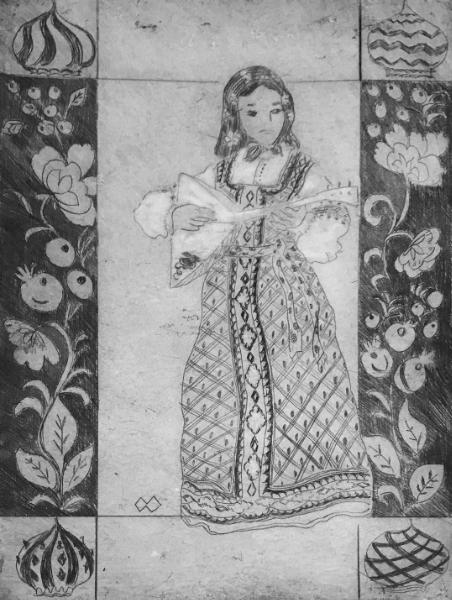 |
People/Country Russia Instrument: Balalaika Border: Khokhloma Corners: St. Basil’s Cathedral domes Dry point etching
Добрый день [ Dobryj den ] Hello
String Instrument: Balalaika The distinctive triangle-shaped Balalaika is often associated with Russian folk songs and folk dances, and has been part of Russian culture since the late 17th century (1688). This instrument has only three strings, but actually comes in a variety of sizes (small to very large) to provide variations from piccolo balalaika to bass balalaika. The modern version was created in 1880 by Vasilii Andreev. Figure and folk attire: Thank you, Nikolay Bogdanov-Belsky ( https://www.wikiart.org/en/nikolay-bogdanov-belsky/balalaika-player) As I was researching this instrument, I came across a painting “Balalaika Player” by the artist Nikolay Bogdanov-Belsky done in 1930. I instantly fell in love it. On one level, it might be that I’m the mother of two boys, and found this little charmer most lovable, with his pensive look. But it was the artistic elements that really engaged me. I thought you might be interested in how the mind of an artist works, how one image can inspire another. The first thing I noticed (and I’m sure you did also) is the background, which of course sets off the nearly monochromatic figure and the red shirt that connects of the figure to his setting. You may be familiar with the work of contemporary artist Kehindy Wiley, who painting a portrait of former President Obama. If you thought that his “busy,” dramatic, almost wall-paper-like background was a new idea, you can see, artists have used the idea for some time. Think of Matisse. This etching series doesn’t allow for that, but I’ll try to remind myself of it when next I paint. The other thing that captured my attention was the pose. I’ve been looking at a lot of images, most are straight forward front views, with the instrument parallel to the picture plain. But this one provides a subtle angle that positions the balalaika so the neck seems to extend toward the viewer. I loved that simple compositional element, and I use it for inspiration as I created this etching. (Of course, I had to remember to think of everything in reserves because it is a print.) Sarafan: The figure in this etching is wearing a typical Russian outfit consisting of a jumper (a long skirt that hangs from just under the arms ) called a sarafan and a white blouse with stitchery trim. Peasants have worn variations of this attire since the 9th century, despite Tsar Peter the Great's ban on traditional cloths in 1700 in favor of Western European fashions. Today, sarafans are consider folk dress and worn mostly at celebrations and folk festivals. Border: Taking its name from a village in the Novgorod region of central Russia, Khokhloma is the folk art of hand painting wood in bright red, gold and black colors. The shapes are usually berries, flowers and leaves in a curvy, flourished style. The idea of painting wood to look like gold, without actually using gold, was adapted from the technique of painting Orthodox religious icons. It involves a five-step process using tin foil (for shine), paint, gold leaf, and high temperature to produce the gold-like lacquer. Originally made by monks for Russian nobility and the Royal family, by the 19th century is was used for everyday utensils and tableware. Today it is identified with Russia and is a popular tourist souvenir. I've attached a white-line linocut print I created of two such souvenirs brought back from Russia by my parents. Corners: Onion domes of St. Basil’s Cathedral (officially Pokrovsky Cathedral) St. Basil’s Christian Orthodox church, located in Moscow, Russia’s Red Square, was built in only six years and consecrated in 1561. To me (and I think most viewers), St. Basil’s Cathedral looks like a fantasy creation or an elaborately decorated cake. Not surprisingly, it is on the UNESCO World Heritage Sites list, as it is a mix of Byzantine, Muslim, Renaissance, and 16th century Russian styles, and is completely unique. Interestingly, the main part of the church is built of red brick, which was a new material at the time. It wasn’t until the 1670s that the original gold gilded domes were replaced with the colorful domes we have come to know. The domes are covered with sheets of colored metal. Hundreds of pieces of various sizes and shapes have been fitted together and riveted into place. Four of the dome patterns are shown in the corners of this etching. References and Links ( Note: I do not endorse or mean to promote any of these sites.) - Dorofeeva, Evgenia A Brief History of the Sarafan. The Russion Fashion Blog. 7/2013. https://www.russianfashionblog.com/index.php/2013/07/history-sarafan/
- Russian Embroidery. https://trc-leiden.nl/trc-needles/individual-textiles-and-textile-types/samplers/russian-embroidery
- About Russian Khokhloma. https://www.greatrussiangifts.com/about-Russian-khokhloma/
- (https://tmora.org Museum of Russian Art)
- (therussianstore.com)
- The Roof Construction of St. Basil’s Cathedral 29/6/2012 https://www.kiddroof.com/roof-construction-st-basils-cathedral/
- 17 Fun Facts About St Basil’s Cathedral. 9/10/2020.https://www.listerious.com/facts-about-st-basils-cathedral/
- Russian Embroidery. https://www.russianfashionblog.com/index.php/2013/05/russian-embroidery/
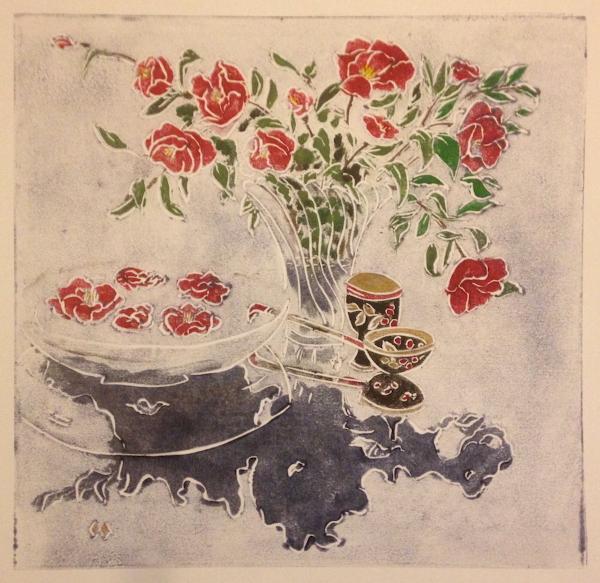 |
Be the first to post a comment.
|
2/27/21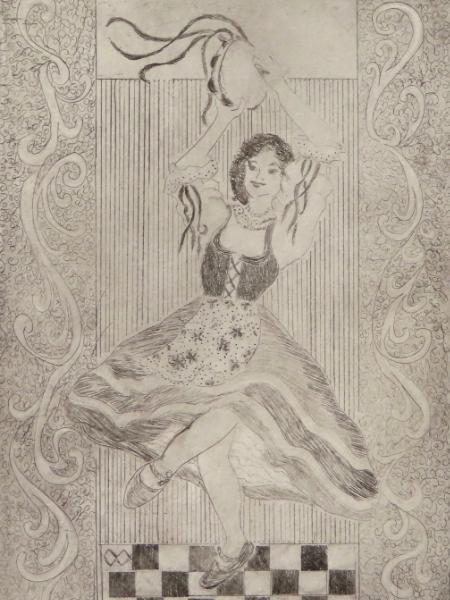 |
Country: Italy Drum: tambourine Border: Florentine design. Chess board (living chess game) Dry point etching Buongiorno/Good Day
Ciao/Hello/Goodbye/Greeting (Pronounced: cha-ow)
Drum: A Tambourine is a hand-held drum, with the leather “head” stretched around a thin, circular frame. Often pairs of metal disks called zills are inserted into the frame to provide a jingling rhythm sound when the drum is struck by hand or “rolled” (shaken back and forth). The Tambourine (or similar smaller instruments) is found in references from Mesopotamia, Egypt, Israel, West Africa, Greece and Ancient Rome. Dance: Tarentella The Tarantella is a traditional folk dance from the region of Calabria in southern Italy. It is one of the country’s most popular dances, performed at weddings, celebrations, and happy gatherings of all sorts. The dance is upbeat, with quick steps, and is often performed in a sideways line with participants (including children and seniors) holding hands. It can also be performed by couples as a courting dance. As I was working on this project, I was surprised to find the origin of the name comes from a kind of wolf spider (not related to the big, furry, poisonous spider you are probably thinking about.) This spider was first found in the province of Taranto, Italy. Some folks thought fast twisting and jumping could serve as an antidote to the spider bite, while others thought the action was a result of the bite. (I had never heard these name explanations before.) Since my father’s family came from Calabria, I have danced many Tarantellas at family weddings, from when I was a little girl being pulled into the line by “old” aunts to becoming one of the aunts (not too old, now) who does the gathering. Just working on this art piece brought back wonderful memories. Traditional Attire: The dancer in this print wears the traditional folk dress of the region: a ribbon decorated skirt, white “peasant” blouse, laced weskit and white apron. Sometimes a large, triangular scarf is tied around the dancer’s waist. Ribbons are often attached to the blouse and to the tambourine, also. Border: The border I chose to create was based on an Italian Renaissance design. I have always loved the swirling graceful patterns, so prevalent in Florence and elsewhere in Italy. I started with the large flourishes on a hand-made ceramic plate I bought in Tropea, Italy, and then added the Florentine swirls to create tonal value. Tropea, is a picturesque cliff-side village in Calabria (Southern Italy) on the Tyrrhenian coast.
The checkerboard base border is a reference to a marvelous event I witnessed on the other side of Italy, near the northern border in Marostico, at the edge of the Alps. This castle town has a huge chessboard in its central plaza. Every other year since 1454 (at least according to legend), a live chess game has been played here. The spectacle of the show, with costumed performers and live horses (chess knights) is quite wonderful to see. If you want to learn more about this event and see some photos, I’ve attached an article I wrote about it for Renaissance magazine in 2019 (you may be able to enlarge it) and a photo showing the Knights on horseback, the queen and other players.. References and Links: Tambourine. Encyclopedia Britannica. https://www.britannica.com/art/tambourine 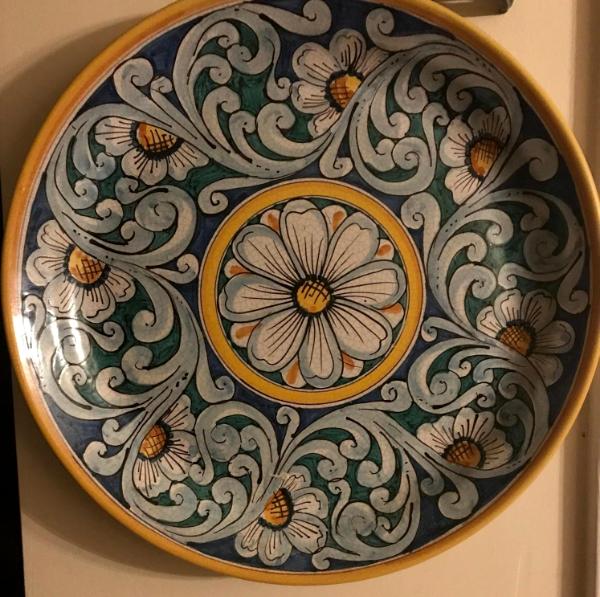 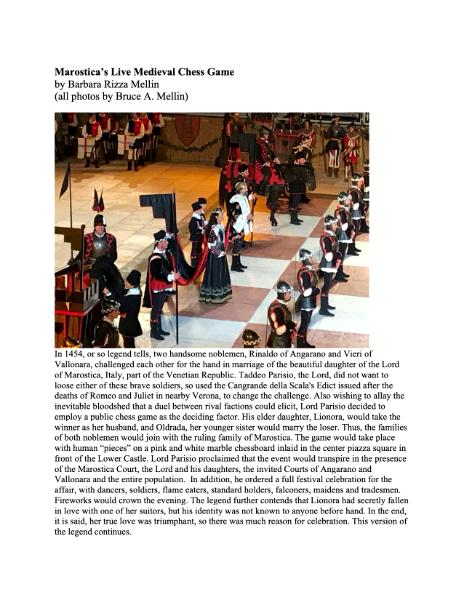 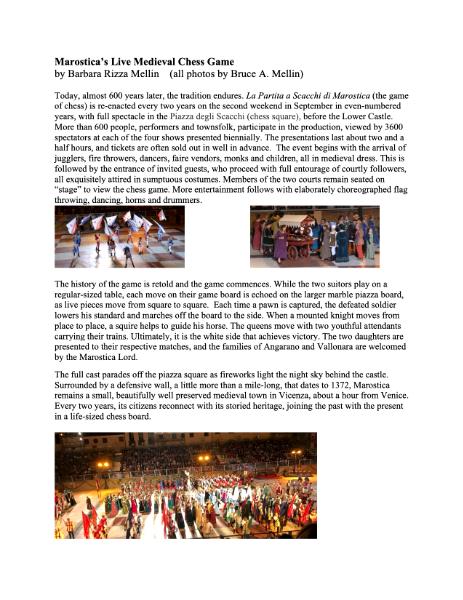 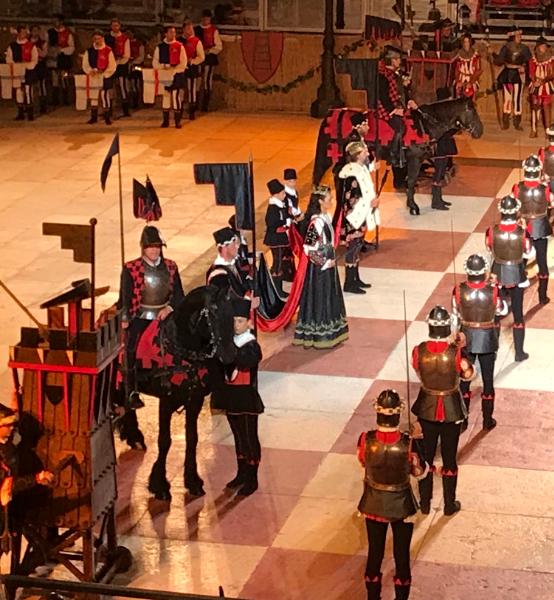 |
Be the first to post a comment.
|
Previously published:All 24 blog entries The Art and Writing of Barbara Rizza Mellin RSS |  |
|